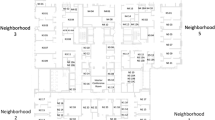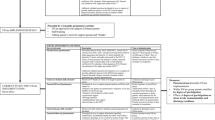Abstract
Objective:
To compare perceived workplace quality in an open-bay neonatal intensive care unit (NICU) and a single-family room (SFR) NICU.
Study Design:
Prospective non-randomized, non-controlled cohort study.
Result:
Staff workplace quality perceptions assessed included the following: the quality of being a Sanford Health System employee (NS—not significant), the quality of the NICU physical work environment, the quality of NICU patient care, the job quality in the NICU, the quality of health and safety in the NICU (NS), the quality of safety and security in the NICU, the quality of interaction with other members of the NICU health-care team (NS; in subanalysis nurse scores significantly declined), the quality of interaction with NICU technology and the off-job quality of life (NS). Scores for each category and the total scores were statistically greater in the SFR, except as noted (NS).
Conclusion:
Staff perceptions of workplace quality were significantly greater in the SFR than the open-bay NICU.
This is a preview of subscription content, access via your institution
Access options
Subscribe to this journal
Receive 12 print issues and online access
$259.00 per year
only $21.58 per issue
Buy this article
- Purchase on Springer Link
- Instant access to full article PDF
Prices may be subject to local taxes which are calculated during checkout

Similar content being viewed by others
References
Als H . Toward a synactive theory of development: promise for the assessment and support of infant individuality. Infant Mental Health J 1982; 3: 229–243.
Als H, Lawhon G, Duffy FH, McAnulty GB, Gibes-Grossman R, Blickman JG . Individualized developmental care for the very low-birth-weight preterm infant. Medical and neurofunctional effects. JAMA 1994; 272: 853–858.
Elander G, Hellstrom G . Reduction of noise levels in intensive care units for infants: evaluation of an intervention program. Heart Lung 1995; 24: 376–379.
Gray L, Philbin MK . Effects of the neonatal intensive care unit on auditory attention and distraction. Clin Perinatol 2004; 31: 243–260 vi.
Graven SN . Early neurosensory visual development of the fetus and newborn. Clin Perinatol 2004; 31: 199–216 v.
Schaal B, Hummel T, Soussignan R . Olfaction in the fetal and premature infant: functional status and clinical implications. Clin Perinatol 2004; 31: 261–285 vi–vii.
Rivkees SA . Emergence and influences of circadian rhythmicity in infants. Clin Perinatol 2004; 31: 217–228 v–vi.
IFCC. Institute for Family-Centered Care 2009 (cited 2009 6/17/2009) Available from www.familycenteredcare.org.
White RD . Mothers′ arms—the past and future locus of neonatal care? Clin Perinatol 2004; 31: 383–387 ix.
Heuer L, Bengiamin M, Downey VW, Imler NJ . Neonatal intensive care nurse stressors: an American study. Br J Nurs 1996; 5: 1126–1130.
Shepley MM, Harris DD, White R . Open-bay and single-family room neonatal intensive care units: caregiver satisfaction and stress. Environ Behavior 2008; 40: 249–268.
Harris DD, Shepley MM, White RD, Kolberg KJS, Harrell JW . The impact of single family room design on patients and caregivers: executive summary. J Perinatol 2006; 26: S38–S48.
White R, Whitman T . Design of ICUs. Pediatrics 1992; 89: 1267.
Shepley MM . Evidence-based design for infants and staff in the neonatal intensive care unit. Clin Perinatol 2004; 31: 299–311 vii.
Altimier LB, Eichel M, Warner B, Tedeschi L, Brown B . Developmental care: changing the nicu physically and behaviorally to promote patient outcomes and contain costs. Neonatal Network 2005; 18: 12–16.
Bruns DA, Klein S . An evaluation of family-centered care in a level III NICU. Infants and Young Children 2005; 18: 222–233.
Symington A, Pinelli JM . Distilling the evidence on developmental care: a systematic review. Adv Neonatal Care 2002; 2: 198–221.
White RD . Recommended standards for newborn ICU design. J Perinatol 2006; 26: S2–S17.
Dodd VL . Implications of kangaroo care for growth and development in preterm infants. J Obstet Gynecol Neonatal Nurs 2005; 34: 218–232.
Feldman R, Eidelman AI, Sirota L, Weller A . Comparison of skin-to-skin (kangaroo) and traditional care: parenting outcomes and preterm infant development. Pediatrics 2002; 110: 16–26.
Consolvo CA . Relieving parental anxiety in the care-by-parent unit. J Obstet Gynecol Neonatal Nurs 1986; 15: 154–159.
Narayanan I, Kumar H, Singhal PK, Dutta AK . Maternal participation in the care of the high risk infant: follow-up evaluation. Indian Pediatr 1991; 28: 161–167.
Stevens DC, Akram Khan M, Munson DP, Reid EJ, Helseth CC, Buggy J . The impact of architectural design upon the environmental sound and light exposure of neonates who require intensive care: an evaluation of the Boekelheide Neonatal Intensive Care Nursery. J Perinatol 2007; 27(Suppl 2): S20–S28.
NACHRI. NICU: Sanford Children's Hospital NICU (Image 9). NACHRI Seeing is Believing Visual Guide 2009 (cited 2009 9/9/2009) Available from: http://www.childrenshospitals.net/Visual_Design_Guide/album/index.html.
Smith TJ, Orfield S, Role M . Sources of variance in employe perceptions of occupancy quality Proceedings of the Human Factors and Ergonomics Society 48th Annual Meeting; 2004 Human Factors and Ergonomics Society: Santa Monica, CA, 2004, pp 1101–1105.
Smith TJ, Clayton S, Schoenbeck K . Transition from an open bay to a private room neontal intensive care unit design—a human factors evaluation Proceedings of the Human Factors and Ergonomics Society 49th Annual Meeting; 2005 Human Factors and Ergonomics Society: Santa Monica, CA, 2005, pp 974–978.
Smith TJ, Schoenbeck K, Clayton S . Staff perceptions of work quality of a neonatal intensive are unit before and after transition from an open bay to a private room design. J Prevention, Assessment and Rehabilitation 2009; 34, in press.
Woolson R . Statistical Methods for the Analysis of Biomedical Data. John Wiley & Sons: NY, New York, 1987.
Aardex Corporation. User Effective Buildings. Aardex Corporation: Denver, CO, 2004 204pp.
Melchior M, Caspi A, Milne BJ, Danese A, Poulton R, Moffitt TE . Work stress precipitates depression and anxiety in young, working women and men. Psychol Med 2007; 37: 1119–1129.
Walsh WF, McCullough KL, White RD . Room for improvement: nurses′ perceptions of providing care in a single room newborn intensive care setting. Adv Neonatal Care 2006; 6: 261–270.
Fogg L, Gross D . Threats to validity in randomized clinical trials. Res Nurs Health 2000; 23: 79–87.
Helseth CC, Stevens DC, Svien LR, Schmitz H, Reid EJ . The effect of neonatal intensive care unit design upon distanc walked by nurses. 21st Annual Gravens Conference for the Physical and Developmental Environment of the High Risk Infant. University of South Florida: Clearwater Beach, FL, 2008.
Welton JM, Decker M, Adam J, Zone-Smith L . How far do nurses walk? Medsurg Nurs 2006; 15: 213–216.
Lin KC, Huang CC, Wu CC . Association between stress at work and primary headache among nursing staff in Taiwan. Headache 2007; 47: 576–584.
Piko B . Work-related stress among nurses: a challenge for health care institutions. J R Soc Promot Health 1999; 119: 156–162.
Stevens DC, Helseth CC . Recent Evidence Based Design Research in Children's Hospital Critical Care Units. 2009 NACHRI 2009 Facilities Design Conference (cited 2009 6/17/2009) Available from http://www.childrenshospitals.net/AM/Template.cfm?Section=Educational_Sessions2&TEEMPLATE=/CM/ContentDisplay.cfm&CONTENTID=44444.
Acknowledgements
This work was supported by grants from the following organizations: the Sanford Health System, the Sanford Health Research Foundation, the Foundation for the Advancement of Medical Education and Research of the Sanford School of Medicine of the University of South Dakota and the Leadership Education Excellence in Neurodevelopmental Disabilities (LEND) Program of the Center for Disabilities of the Sanford School Medicine of the University of South Dakota (sponsored by the Maternal and Child Health Bureau of the Health Resources and Services Administration, Grant T73MC00037).
Author information
Authors and Affiliations
Corresponding author
Ethics declarations
Competing interests
The authors declare no conflict of interest.
Additional information
Supplementary Information accompanies the paper on the Journal of Perinatology website
Rights and permissions
About this article
Cite this article
Stevens, D., Helseth, C., Khan, M. et al. Neonatal intensive care nursery staff perceive enhanced workplace quality with the single-family room design. J Perinatol 30, 352–358 (2010). https://doi.org/10.1038/jp.2009.137
Received:
Revised:
Accepted:
Published:
Issue Date:
DOI: https://doi.org/10.1038/jp.2009.137
Keywords
This article is cited by
-
Evidence-based design for neonatal units: a systematic review
Maternal Health, Neonatology and Perinatology (2019)
-
The business case for building better neonatal intensive care units
Journal of Perinatology (2014)
-
A comparison of the direct cost of care in an open-bay and single-family room NICU
Journal of Perinatology (2014)
-
NICU redesign from open ward to private room: a longitudinal study of parent and staff perceptions
Journal of Perinatology (2013)
-
The single-patient room in the NICU: maternal and family effects
Journal of Perinatology (2012)



